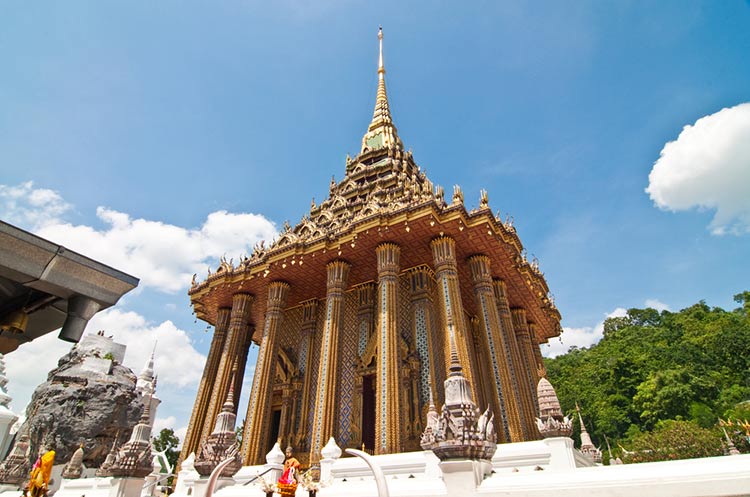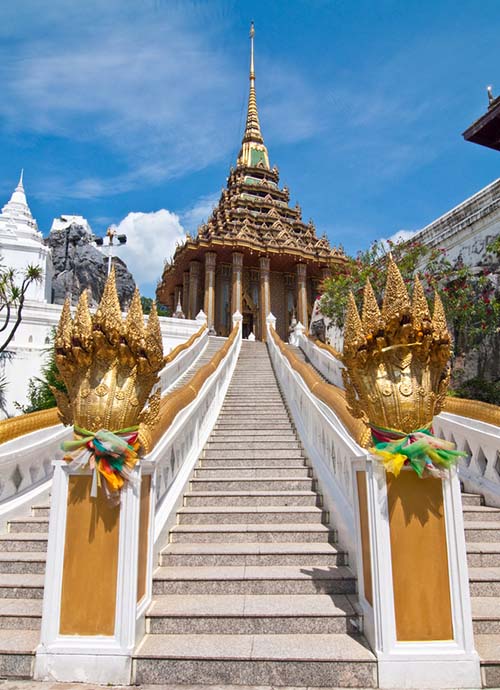
Wat Phra Phutthabat
The “temple of the Buddha’s footprint”
Saraburi
The Wat Phra Phutthabat, the “temple of the Buddha’s footprint” is an important Buddhist pilgrimage site located in a rural area between the towns of Lopburi and Saraburi. A mondop on top of a small hill houses a footprint of the Buddha, that was discovered in the 17th century.
Highly revered temple
The Wat Phra Phutthabat is a highly revered temple; it is one of the six temples of the highest grade of the first class Royal temples. The temple’s full name is Wat Phra Phutthabat Ratchaworamahaviharn, which means “Great Royal Temple of the Buddha’s Footprint”.
Legend of the Buddha’s footprint
The temple was founded by King Songtham, King of the Ayutthaya Kingdom during the early 17th century. According to legend, the King sent out monks to Sri Lanka to pay tribute to the footprints of the Buddha there. Upon arrival, the monks were told that the Buddha had also traveled through Thailand and that there should be footprints in their own country. On the monks’ return, the King ordered his people to search for the footprints of the Buddha in his Kingdom.
The legend tells a local man discovered the footprints by chance in 1623, when he followed a wounded deer. When the deer emerged from the bushes, it was fully cured and ran away. Pushing aside the bushes the man found a large footprint filled with water. After drinking the water, he was immediately cured from a bad skin disease. After hearing of the discovery, the King ordered a temple to be build over the footprint of the Buddha.
The temple was destroyed in 1765 during the Burmese-Siamese war that meant the end of the Ayutthaya Kingdom two years later. The present structure dates from the Rattanakosin era.
The mondop housing the Buddha footprint
The footprint is housed in a very ornate mondop on top of a small hill. A triple staircase flanked by Naga balustrades leads to the top. At the bottom of the stairs are bronze five headed Naga snakes, the mythological serpent’s body extending over the balustrades towards the platform. The three part staircase is said to represent the three ladders used to descend from the Trayastrimsa Heaven; a ladder of jewels used by the Buddha, a ladder of gold used by Indra and a ladder of silver used by Brahma.
The mondop is set on a marble platform. The square structure surrounded by pillars has a seven tiered roof laid with green ceramic tiles, its doors inlaid with intricate mother of pearl decoration.

The footprint housed in a golden case
The footprint which is of considerable size, about 150 cm long and 52 cm wide, is housed in a richly decorated golden case covered with layers of gold leaf applied to it by devotees. The footprint is obscured from sight as it is covered with coins and banknotes thrown in there by Buddhist devotees. Around the mondop are lines of bells that can be gonged in order to make merit.
Assembly hall & ordination hall
The viharn and ubosot of the temple complex were added later and are in Ayutthaya and Rattanakosin style. To learn about your future, try one of the electronic fortune telling machines set up around the complex.
Museum
A museum on the grounds exhibits various items including pottery from Sukhothai, porcelain items, 17th century clothing, weapons and the original roof of the mondop, that was destroyed by the Burmese.
Holy Footprint festival
Twice a year, in February and March, the festival of the Holy Footprint is held at the temple. At this time hundreds of thousands of Buddhist pilgrims visit the Wat Phra Phutthabat temple to pay respect to the Buddha’s footprint. At the grounds are all kinds of entertainment, shows, music and plenty of stalls with souvenirs and food.
How to get to the Wat Phra Phutthabat
The temple is located in Phra Phutthabat district in Saraburi province along Phahonyothin road (Highway 1) between Saraburi town and Lopburi town, about 30 kilometers North West of Saraburi town. Coming from Saraburi, the temple is on the left hand side of the road at about 1 kilometer from Highway 1.
To get there, take a bus from Saraburi to Lopburi and get off at the 14 kilometer marker. Buses run multiple times per hour and cost about 30 Thai Baht.
Opening hours
The temple opens daily during daylight hours.
Entrance fee
Admission charged at the ticket booth is (Thai Baht):